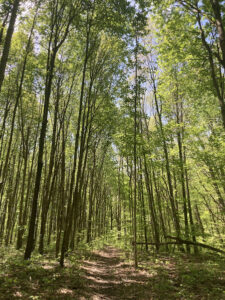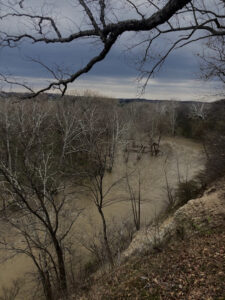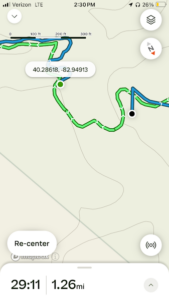The Romatics believed nature was healing–and science has proved that to be true! We all need time in the sunshine no matter how busy our schedules are. But now that finals are over and you can wander outside again, how are you going to embrace your inner Romantic?
William Worthsworth was a champion hiker. By some estimates, the poet walked as many as 180,000 miles over the course of his life. While I have not traversed Tintern Abbey, I have explored local hiking opportunities in central Ohio to see what the area has to offer. Along the way, I’ve encountered some challenging trails filled with mud baths, steep ascents, and poison ivy. But, through taking time this spring to explore, I’ve also uncovered some true hiking gems. The following are two trails you may want to try if you are looking to reconnect with Mother Nature!

Hunter’s Hollow Bridle Trail
Hunter’s Hollow Bridle Trail is located in Alum Creek State Park, about 15-20 minutes from campus. This 6.5-mile in-and-out trail is primarily used by horseback riders, so watch out for horse droppings throughout the trail! Despite its intended use, it’s great for a beginner to moderate level hike. The trail will take you through several loops that border Alum Creek Lake and will lead you through pine forests and deciduous trees. You will see many animal tracks such as horse, deer, raccoon, and dog. There are many steep ascents and challenging stream crossings but they are generally brief, and keep the hike exciting! This trail can be challenging because it is poorly marked, but it can be completed with proper navigational preparation (see below). The trail ends at a high elevation and provides a beautiful view of the lake. This is a great opportunity for journaling, resting, or reflection.

Alum Creek Phase 1 Trail
The Alum Creek Phase 1 Trail is among my favorite trails in Alum Creek State Park. While this 5.5 mile trail is originally intended for mountain biking, it is a wonderful location for a beginner to moderately challenging hike. Because of its intended use, pay attention to the sign that informs you of the direction bikers should be riding. Walk the opposite direction so you are against any bike traffic! This loop trail is quite hilly and can become very muddy during times of heavy rain, so it’s best to wait until the weather is fairly dry. While you hike through the deciduous forest, you will get opportunities to walk close to the water. This allowed me to see many beautiful bird species, such as great blue herons and hawks. The trail is marked fairly well and is the perfect distance for a brief day hike!

Where to look?
You may be wondering how enchanting trails such as these can be easily found. While state park maps are a very good option, my favorite method is to use the AllTrails app. Simply download the free app and enter your area code to instantly get trail recommendations near you. You can cater them to your specific needs by using their detailed filter system and make personalized lists to organize your future ventures. This app is wonderful because it has over 200,000 trails for you to explore! Also, it functions as a GPS and can log all your past hikes.
What to pack for a successful hike
You’ve found a trail, but you must prepare for your adventure. Packing the correct gear will make your hiking experience enjoyable and safe! The following are necessary items to take along with you!
- Hiking pack: Whether this is your school backpack or a hiking pack, it’s important to have a bag to carry the necessities. From my experience, a regular backpack is great for hikes from one to five miles because you don’t need to carry a lot of gear or water. The downside is you may experience the same stress you feel on your shoulders from a normal backpack–but because your hike isn’t very long, it will be short-lived. A regular backpack is a great option for new hikers or those who don’t want to spend money on specialized gear! A hiking pack may come in handy when you extend the miles beyond six or seven or if you are on a trail with a significant elevation gain. Not only do hiking packs hold gear more efficiently, but they also help distribute the weight from your shoulders and lessen any potential strain.
- Food and water: Packing plenty of snacks and water is very important when venturing out on a hike! Even if you only intend to go two or three miles, packing more food than you anticipate needing is key. You must consider that there may be unforeseen situations. Maybe your blood sugar could crash, you encounter a hungry hiker, or perhaps you might take a wrong turn and be hiking for many more miles than expected. The best hiking food is typically nutrient-dense so that you get food with the maximum amount of calories but the lightest weight. Foods such as trail mix, jerky, energy bars, chews, or gels, tuna pouches, or peanut butter are all great options. Above food, you must be sure to pack enough water. The general rule is 33oz of water for every five miles hiked, but that is just a baseline. I often find I need more, especially if it is warm.
- Weather-appropriate clothing and footwear: The importance of appropriate clothing is often overlooked, but it is one of the most crucial aspects of hiking! Becoming too cold or hot can be extremely dangerous, especially when you have miles left on your hike or if you are alone. Take a careful look at the weather and pack accordingly. Wear layers so you have plenty of options to adjust your temperature, and pack a few additional layers as well! Appropriate footwear is also crucial. Be sure to wear closed-toed shoes that fit well. Hiking boots are a great option because they support the ankle, but tennis shoes work great as well!
- First aid kit and knife or multi-tool: A first aid kit is necessary for both beginners and experienced hikers. You never know what could happen out in nature, so it’s crucial to be prepared for emergencies. And even if you don’t have an emergency, it’s nice to have a band-aid if you happen to develop a blister. A knife or multi-tool is also an important piece of gear to have for preparedness.
- Sun protection: Especially when one is hiking in hot weather, having the proper protection from the sun will make your hike safer and more enjoyable. Bring the appropriate sunscreen, sunglasses with a strap, a protective hat, and possibly a lightweight long sleeve shirt to protect the skin.
- Navigational tools: While some trails may be marked exceedingly well, the reality is many trails are very poorly marked and one can easily lose their way. It is incredibly important to not solely rely on trail markings, and instead, equip yourself with tools. Find a map of the trail you are taking and keep that with you. Also, take along a compass to assist with navigation. Apps such as AllTrails, Strava, Gaia, and FarOut can also be very helpful with navigation. Be sure to bring a backup phone charger if you will be relying on your phone! And while apps are handy, remember that signal is not guaranteed and the most reliable methods are ones that can be used without technology.
A note on safety
An extremely important safety precaution is telling someone close to you where you are hiking. Share the name of the trail you plan to hike, the time you expect to return home, and a map of your route. An alternative to this is to share your location via your phone with a close friend. This way, they can know your exact location in case something goes wrong and get you help as quickly and efficiently as possible.
* * *
With summer just around the corner, take this opportunity to get out into the fresh air and receive the rich goodness nature can offer us. Hiking is only one way of enjoying the outdoors, so keep searching for the activity that suits you best. Whatever you settle on, keep exploring all the experiences this earth has to offer! Then write about your adventures for The Sturges Script when you get back!

